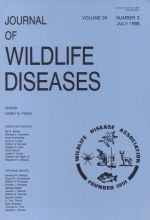In four separate trials, 10 coyotes (Canis latrans) which had been individually fed mascerated bovine placental tissue experimentally inoculated with Brucella abortus strain 2308 were placed in a 1 ha isolation area with six parturient, non-B. abortus vaccinated, Brucella spp. seronegative Hereford heifers. During the second trial, three of the heifers became Brucella spp. seroreactive (as determined by the card, standard agglutination tube, rivanol, complement fixation, and enzyme labeled immunosorbent assay tests) 14 days after exposure to the B. abortus infected coyotes. Five of 10 coyotes in the second trial seroconverted to Brucella spp. positive by day 14 postexposure (PE) and by day 27 PE seven of the 10 coyotes were Brucella spp. reactive. The three Brucella spp. seroreactive heifers subsequently aborted on days 35, 64 and 66 PE and B. abortus strain 2308 was isolated from vaginal swabs, milk, and placental and fetal tissues. There was no serologic or bacteriologic evidence of transmission from B. abortus infected coyotes to the susceptible cattle recorded in the other three trials.
How to translate text using browser tools
1 July 1988
INTERSPECIFIC TRANSMISSION OF BRUCELLA ABORTUS FROM EXPERIMENTALLY INFECTED COYOTES (CANIS LATRANS) TO PARTURIENT CATTLE
Donald S. Davis,
Fred C. Heck,
John D. Williams,
T. R. Simpson,
L. Garry Adams

Journal of Wildlife Diseases
Vol. 24 • No. 3
July 1988
Vol. 24 • No. 3
July 1988
Brucella abortus
Canis latrans
coyote
domestic cattle
experimental study
interspecific transmission
serology




